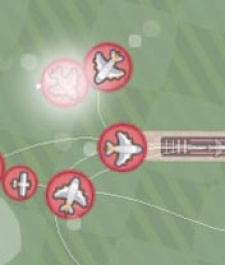It all began with an unassuming little title called Flight Control. At the time, it was almost billed as a throwaway release from a company with a bigger fish to fry. Flight Control was coded on the side by CEO Robert Murray, while he was grappling with the wider complications of Real Racing.
Flying first class
This was back in the early, fertile days of App Store high jinx, where companies were being formalised and careers forged. Even so, its unlikely Firemint could have guessed just how big a hit Flight Control was going to be.
The game spawned imitators almost immediately, which are now affectionately recognised as part of an entire line-drawing genre.
But to label games such as Lion Pride, Peter und Vlad, Boom Brigade, DrawRace, Heli Rescue or Harbor Master as mere facsimiles of Flight Control fails to recognise the flexible genius of Firemints design masterstroke.
For those not familiar with Flight Controls central mechanic, the idea is to trace lines on the touchscreen in order to lead planes and helicopters to their appropriate runways without causing any of them to collide. It makes use of two of gamings oldest sources of challenge; the balancing of focused attention against targeted distraction.
Planes, trains, boats and automobiles
But now that the formula has been tweaked and nuanced into so many new forms, where will the line drawing genre go next?
Will it have the sustainability of other mobile staples, such as tower defense or match-three puzzlers?
Or will it eventually collapse into reskinned nonsense: angry bees chasing people eating ice creams? Sharks chasing seals and scuba divers? Cowboys and cops versus robbers and indians?
All of the facile examples above will probably hit the App Store before the end of the year, but in order to really cement line-drawing as a genre with lasting appeal, we may need to look backwards as well as forwards.
Less is more
One of the things Flight Control demonstrates perfectly is that the simpler the scoring mechanism, the easier the boasting rights.
Everyone who has played Flight Control can understand what 127 planes landed means. This is something a points-based system communicates less successfully, whether that be on a global leaderboard or on Twitter or Facebook Connect.
So thats the backwards, but what of the forwards?
Is it possible to add depth and contextually relevant originality while maintaining that all important simplicity and fun?
Doctors and nurses
How about a hospital-themed line-drawing game where you have a birds eye view of the floor plan? Doctors, nurses, janitors, receptionists, IT staff and surgeons need to be allocated to the corresponding areas, but only one per location as and when required.
Is it worth drawing a line to send a surgeon straight to theatre? Or should you get the maintenance guy in first to fix the heart monitor machine so that future operations have a higher chance of success?
Should you send a doctor straight to the A&E ward to save one patient, or do you risk that patients life by sending a janitor to clean up first, so as to avoid a potential outbreak of MRSA and the death of several more patients?
Too many lines?
Certainly the process of hybridising line-drawing with other genres such as resource and time management has already begun.
What's harder to know however is whether adding these extra layers of abstraction to Firemints original conceit will ultimately develop the genre or cause it to collapse in upon itself.
Sometimes simplicity is its own reward.
Gaming trends: Are we at the end of the line-drawing genre?
The future that Firemint sketched




















